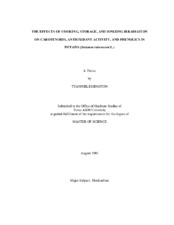| dc.description.abstract | Past research conducted by our lab demonstrated that potatoes contain significant
levels of phytochemicals important to human health. However, since potatoes are not
consumed raw, it is important to determine the effects of processing on these levels.
Therefore, the changes in carotenoid content, antioxidant activity, and phenolic content
were investigated using combinations of cultivars, cooking methods, storage treatments,
and low-dose ionizing irradiation. Carotenoid content was measured via absorbance at
445 nm, 450 nm, and HPLC identification. Antioxidant activity was measured initially
and at stabilization via the DPPH method and phenolic content was measured via the
Folin method and HPLC identification.
Microwaved, baked, fried, and raw potato samples contained more carotenoids
than boiled samples. The samples microwaved, baked, and fried contained higher
antioxidant activity and phenolics than the boiled or raw samples. However, the
compound quercetin dihydrate appeared to decrease with cooking.
Carotenoids, antioxidant activity, and phenolics appeared to decrease with
storage; however, high storage temperatures and long storage times were believed to
cause a dehydration and concentration of compounds, which caused levels to be equal to
or greater than before storage. However, this decreasing trend was not linear and there
were multiple significant interactions. The compound chlorogenic acid appeared to be
quite sensitive to high temperature storage.
Irradiation dose appeared to have only a minor, if any, effect on carotenoid
levels. The interaction between storage time and irradiation dose was very influential on
antioxidant activity. In early stages of storage, higher doses of irradiation had greater antioxidant activity, while, with continued storage, low doses had higher antioxidant
activity. Exposure to irradiation appeared to cause an increase in phenolic content,
determined by the Folin method.
There may be a stimulation, induction, or release of some compounds due to
processing; however, its magnitude is not believed to be as great as genetic control. The
effects of processing can not be denied and should continue to be investigated. Future
studies investigating the health properties of fruits and vegetables, particularly potatoes
should include processing effects. | en |


